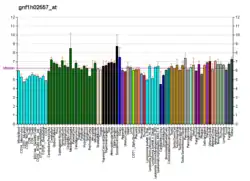TEF (gene)
Thyrotroph embryonic factor is a protein that in humans is encoded by the TEF gene.[5][6][7]
Thyrotroph embryonic factor (TEF), a transcription factor, is a member of the PAR (proline and acidic amino acid-rich) subfamily of basic region/leucine zipper (bZIP) transcription factors. It is expressed in a broad range of cells and tissues in adult animals, however, during embryonic development, TEF expression appears to be restricted to the developing anterior pituitary gland, coincident with the appearance of thyroid-stimulating hormone, beta (TSHB). Indeed, TEF can bind to, and transactivate the TSHB promoter.
It shows homology (in the functional domains) with other members of the PAR-bZIP subfamily of transcription factors, which include albumin D box-binding protein (DBP), human hepatic leukemia factor (HLF) and chicken vitellogenin gene-binding protein (VBP); VBP is considered the chicken homologue of TEF. Different members of the subfamily can readily form heterodimers, and share DNA-binding, and transcriptional regulatory properties.[7]
References
- GRCh38: Ensembl release 89: ENSG00000167074 - Ensembl, May 2017
- GRCm38: Ensembl release 89: ENSMUSG00000022389 - Ensembl, May 2017
- "Human PubMed Reference:". National Center for Biotechnology Information, U.S. National Library of Medicine.
- "Mouse PubMed Reference:". National Center for Biotechnology Information, U.S. National Library of Medicine.
- Khatib ZA, Inaba T, Valentine M, Look AT (Feb 1995). "Chromosomal localization and cDNA cloning of the human DBP and TEF genes". Genomics. 23 (2): 344–51. doi:10.1006/geno.1994.1510. PMID 7835883.
- Inukai T, Inaba T, Dang J, Kuribara R, Ozawa K, Miyajima A, Wu W, Look AT, Arinobu Y, Iwasaki H, Akashi K, Kagami K, Goi K, Sugita K, Nakazawa S (May 2005). "TEF, an antiapoptotic bZIP transcription factor related to the oncogenic E2A-HLF chimera, inhibits cell growth by down-regulating expression of the common beta chain of cytokine receptors". Blood. 105 (11): 4437–44. doi:10.1182/blood-2004-08-2976. PMID 15665112.
- "Entrez Gene: TEF thyrotrophic embryonic factor".
Further reading
- Drolet DW, Scully KM, Simmons DM, et al. (1991). "TEF, a transcription factor expressed specifically in the anterior pituitary during embryogenesis, defines a new class of leucine zipper proteins". Genes Dev. 5 (10): 1739–53. doi:10.1101/gad.5.10.1739. PMID 1916262.
- Hunger SP, Li S, Fall MZ, et al. (1996). "The proto-oncogene HLF and the related basic leucine zipper protein TEF display highly similar DNA-binding and transcriptional regulatory properties". Blood. 87 (11): 4607–17. PMID 8639829.
- Ossipow V, Fonjallaz P, Schibler U (1999). "An RNA Polymerase II Complex Containing All Essential Initiation Factors Binds to the Activation Domain of PAR Leucine Zipper Transcription Factor Thyroid Embryonic Factor". Mol. Cell. Biol. 19 (2): 1242–50. doi:10.1128/mcb.19.2.1242. PMC 116053. PMID 9891058.
- Dunham I, Shimizu N, Roe BA, et al. (1999). "The DNA sequence of human chromosome 22". Nature. 402 (6761): 489–95. Bibcode:1999Natur.402..489D. doi:10.1038/990031. PMID 10591208.
- Krueger DA, Warner EA, Dowd DR (2000). "Involvement of thyrotroph embryonic factor in calcium-mediated regulation of gene expression". J. Biol. Chem. 275 (19): 14524–31. doi:10.1074/jbc.275.19.14524. PMID 10799536.
- Strausberg RL, Feingold EA, Grouse LH, et al. (2003). "Generation and initial analysis of more than 15,000 full-length human and mouse cDNA sequences". Proc. Natl. Acad. Sci. U.S.A. 99 (26): 16899–903. Bibcode:2002PNAS...9916899M. doi:10.1073/pnas.242603899. PMC 139241. PMID 12477932.
- Newman JR, Keating AE (2003). "Comprehensive identification of human bZIP interactions with coiled-coil arrays". Science. 300 (5628): 2097–101. Bibcode:2003Sci...300.2097N. doi:10.1126/science.1084648. PMID 12805554.
- Ota T, Suzuki Y, Nishikawa T, et al. (2004). "Complete sequencing and characterization of 21,243 full-length human cDNAs". Nat. Genet. 36 (1): 40–5. doi:10.1038/ng1285. PMID 14702039.
- Collins JE, Wright CL, Edwards CA, et al. (2005). "A genome annotation-driven approach to cloning the human ORFeome". Genome Biol. 5 (10): R84. doi:10.1186/gb-2004-5-10-r84. PMC 545604. PMID 15461802.
- Gerhard DS, Wagner L, Feingold EA, et al. (2004). "The Status, Quality, and Expansion of the NIH Full-Length cDNA Project: The Mammalian Gene Collection (MGC)". Genome Res. 14 (10B): 2121–7. doi:10.1101/gr.2596504. PMC 528928. PMID 15489334.
- Rual JF, Venkatesan K, Hao T, et al. (2005). "Towards a proteome-scale map of the human protein-protein interaction network". Nature. 437 (7062): 1173–8. Bibcode:2005Natur.437.1173R. doi:10.1038/nature04209. PMID 16189514.




